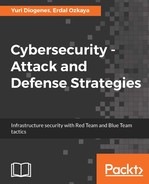Handling an incident in the context of the IR life cycle includes the detection and containment phases. In order to detect a threat, your detection system must be aware of the attack vectors, and since the threat landscape changes so rapidly, the detection system must be able to dynamically learn more about new threats and new behaviors, and trigger an alert if a suspicious activity is encountered.
While many attacks will be automatically detected by the detection system, the end user has an important role in identifying and reporting the issue in case they find a suspicious activity.
For this reason, the end user should also be aware of the different types of attack and learn how to manually create an incident ticket to address such behavior. This is something that should be part of the security awareness training.
Even with users being diligent by closely watching for suspicious activities, and with sensors configured to send alerts when an attempt to compromise is detected, the most challenging part of an IR process is still the accuracy of detecting what is truly a security incident.
Oftentimes, you will need to manually gather information from different sources to see if the alert that you received really reflects an attempt to exploit a vulnerability in the system. Keep in mind that data gathering must be done in compliance with the company's policy. In scenarios where you need to bring the data to a court of law, you need to guarantee the data's integrity.
The following diagram shows an example where the combination and correlation of multiple logs is necessary in order to identify the attacker's final mission:

In this example, we have many IoCs, and when we put all the pieces together we can validate the attack.
The following table explains the diagram in more detail:
|
Step |
Log |
Attack/Operation |
|
1 |
Endpoint protection and operating system logs can help determine the IoC |
Phishing email |
|
2 |
Endpoint protection and operating system logs can help determine the IoC |
Lateral movement followed by privilege escalation |
|
3 |
Server logs and network captures can help determine the IoC |
Unauthorized or malicious process could read or modify the data |
|
4 |
Assuming there is a firewall in between the cloud and on-premises resources, the firewall log and the network capture can help determine the IoC |
Data extraction and submission to command and control |
As you can see, there are many security controls in place that can help to determine the indication of compromise. However, putting them all together in an attack timeline and crossing the data can be even more powerful.
This brings back a topic that we discussed in the previous chapter, that detection is becoming one of the most important security controls for a company. Sensors that are located across the network (on-premises and cloud) will play a big role in identifying suspicious activity and raising alerts. A growing trend in cybersecurity is the leveraging of security intelligence and advanced analytics to detect threats more quickly and reduce false positives. This can save time and enhance the overall accuracy.
Ideally, the monitoring system will be integrated with the sensors to allow you to visualize all events in a single dashboard. This might not be the case if you are using different platforms that don't allow interaction between one another.
In a scenario similar to the one we looked at previously, the integration between the detection and monitoring system can help to connect the dots of multiple malicious actions that were performed in order to achieve the final mission—data extraction and submission to command and control.
Once the incident is detected and confirmed as a true positive, you need to either collect more data or analyze what you already have. If this is an ongoing issue, where the attack is taking place at that exact moment, you need to obtain live data from the attack and rapidly provide a remediation to stop the attack.
For this reason, detection and analysis are sometimes done almost in parallel to save time, and this time is then used to rapidly respond. Having said that, it is important to mention that there is a separate phase for containment eradication and recovery, which is something that is going to be covered in the next section of this chapter.
The biggest problem happens when you don't have enough evidence that there is a security incident taking place, and you need to keep capturing data in order to validate the veracity. Sometimes the incident is not detected by the detection system. Perhaps it is reported by an end user, but he can't reproduce the issue at that exact moment. There is no tangible data to analyze, and the issue is not happening at the time you arrive. In scenarios like this, you will need to set up the environment to capture data and instruct the user to contact support when the issue is currently happening.
